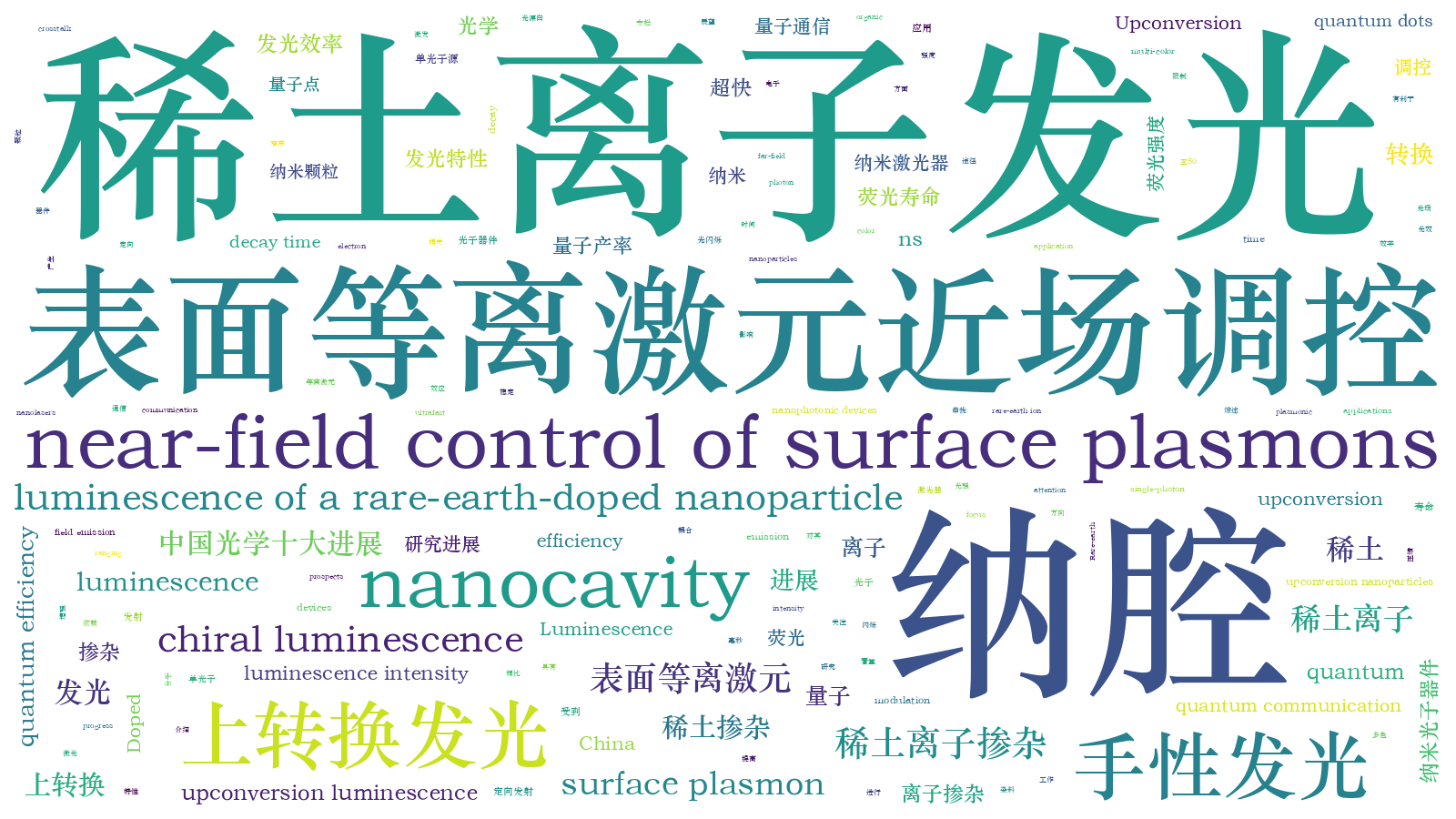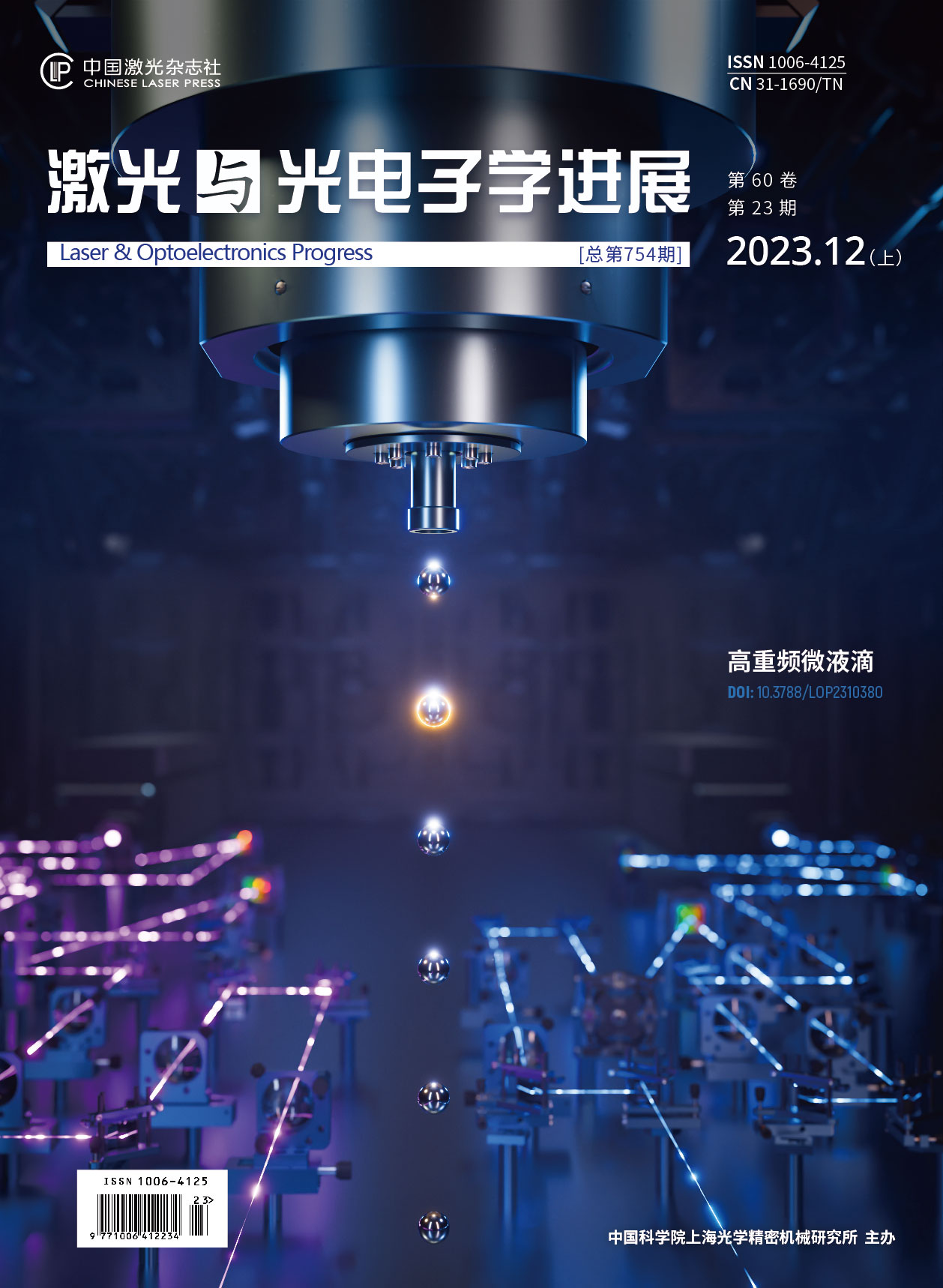中国光学十大进展:亚50 ns超快稀土掺杂上转换发光特邀综述亮点文章【增强内容出版】
1 引言
稀土离子的4f层电子受到外层电子的屏蔽,呈现出丰富的阶梯状能级阵列,可以吸收两个或多个低能光子转换为一个高能光子,从而实现上转换发光(UCL)[1-3]。稀土离子掺杂上转换纳米颗粒(UCNPs)具备稳定、窄带、多色等发光特性,在单光子源[4-7]、量子存储[8-9]、非线性生物成像[10-11]等领域得到广泛应用。然而,由于跃迁选择定则的限制,稀土离子发光具有较长的寿命(微秒到毫秒量级)和较低的量子产率[12-17]。如何将稀土离子荧光寿命压缩至纳秒量级,并同时提升其UCL效率,对稀土离子发光领域的基础和应用研究具有重要意义[18-19]。此外,稀土离子发光的非定向发射、非偏振依赖、低效激发态吸收(ESA)等特性也会影响其在纳米光子器件中的应用。
表面等离激元是金属与介质界面上自由电荷集体相干振荡的现象。金属纳米结构的表面等离激元共振效应能够显著增强光与物质相互作用[20],有助于提高荧光发射速率和强度[21-24]。当发射体靠近等离激元纳米结构时,其自发辐射衰减速率会被改变[25-26],通过进一步构建等离激元纳腔,可以更加紧密地将光限制在金属纳米颗粒的间隙中,从而获得高度局域化的电磁场。利用等离激元纳腔中的Purcell效应,可以提高发射体的局域光子态密度(LDOS),进而实现自发辐射速率的提高和荧光寿命的压缩[27-30]。研究表明,通过提高等离激元纳腔的品质因子或减小其模式体积,可以显著压缩UCNPs的荧光寿命[31],并且不同结构的纳腔能够将稀土离子发光强度增强102~105倍[32]。
本文综述了稀土离子上转换发光的影响因素及调控手段,介绍了等离激元纳腔调控稀土离子发光的相关前沿进展。详细阐述了利用等离激元倾斜纳腔实现超快稀土离子上转换发光的相关研究,该工作将稀土离子4f-4f跃迁发光寿命压缩至50 ns以下,同时保持约1000倍的量子产率增强,并发现了远场定向发射及可调手性发光等新现象。这将有效解决稀土发光寿命长、量子产率低等问题,对完全发挥稀土发光单色性好、稳定性高、相干性强等优势具有重要意义。
2 稀土离子上转换发光
稀土离子特殊的4f电子构型,使其具有高度局域化的能量特性,并且具有丰富的线状能级分布,因此可以高效吸收低能量光子,并通过上转换发射出高能量光子[1, 3]。稀土离子的4f层电子被外层电子屏蔽,使得UCNP表现出丰富的超高分辨跃迁、极长的光学相干时间、kHz及以下级别的均匀谱线宽度、MHz到GHz范围内变化的非均匀谱线展宽和优异的光稳定性[4-5, 7]。这些特点使得UCNP广泛应用于自旋操纵单光子源、光学超分辨成像、光量子存储器、纳米激光器、光遗传学、光催化、非线性生物成像、光热治疗等领域中[8-10, 33-36]。然而,稀土离子特有的4f-4f禁戒跃迁、较低的光吸收及辐射效率导致了稀土离子掺杂发光具有较长的荧光寿命和较低的量子产率,在纳米光学器件中应用受到限制。
影响上转换发射效率的因素包括掺杂稀土离子种类和浓度、基质材料晶相、微纳颗粒尺寸、惰性或活性核壳结构、非稀土离子共掺杂和表面等离激元增强效应等[37]。
![稀土掺杂上转换发光的主要调控方法[38-44]](/richHtml/lop/2023/60/23/2300002/img_01.jpg)
图 1. 稀土掺杂上转换发光的主要调控方法[38-44]
Fig. 1. Main regulation methods of rare-earth-doped upconversion luminescence[38-44]
3 表面等离激元纳腔调控稀土离子发光
表面等离激元纳腔可以看作是将宏观电磁波天线延伸至纳米尺度的纳米光学天线,使得自由空间中的电磁波和微观尺度的局域电(磁)流元产生可逆的转换。等离激元可以突破光学衍射极限,将光束缚在亚波长的尺度,而等离激元纳腔能够捕获远大于自身结构尺寸的光场,并将其束缚在极小的模式体积内,使得受限的局域光场与量子发射体之间的相互作用增强。因此,纳腔被广泛地应用在光学器件和光电器件中,为纳米光学技术发展提供了强大的支持。
利用等离激元纳米结构,可以有效地调控稀土离子发光。这些结构包括单个金属纳米颗粒的等离激元共振、通过自上而下光刻制备的等离激元纳米结构以及通过自下而上组装形成的片上等离激元纳腔等[52]。
![等离激元纳腔调控UCNPs荧光研究成果。(a) 不同等离激元纳腔调控UCNPs荧光强度及寿命的效果对比;(b) 各种等离激元纳腔体系,(i) 倾斜银纳米立方体-单晶银微米片纳腔[45],(ii) 银纳米立方体-金膜纳腔[46],(iii) 金纳米棒纳腔[47],(iv) 金纳米圆柱纳腔阵列[32],(v) 金纳米盘-金膜纳腔阵列[48],(vi) 单晶银微米三角片结构[36],(vii) 金微米片-银微米片纳腔[49],(viii) 金纳米膜包覆光纤腔[50],(ix) 银纳米立方体[51]](/richHtml/lop/2023/60/23/2300002/img_02.jpg)
图 2. 等离激元纳腔调控UCNPs荧光研究成果。(a) 不同等离激元纳腔调控UCNPs荧光强度及寿命的效果对比;(b) 各种等离激元纳腔体系,(i) 倾斜银纳米立方体-单晶银微米片纳腔[45],(ii) 银纳米立方体-金膜纳腔[46],(iii) 金纳米棒纳腔[47],(iv) 金纳米圆柱纳腔阵列[32],(v) 金纳米盘-金膜纳腔阵列[48],(vi) 单晶银微米三角片结构[36],(vii) 金微米片-银微米片纳腔[49],(viii) 金纳米膜包覆光纤腔[50],(ix) 银纳米立方体[51]
Fig. 2. Research results of UCNPs luminescence regulated by plasmonic nanocavities. (a) Luminescence intensities and lifetimes of UCNPs regulated by different plasmonic nanocavities; (b) various plasmonic nanocavities, (i) tilted silver nanocube-silver film nanocavity[45], (ii) silver nanocube-gold film nanocavity[46], (iii) gold nanorod nanocavity[47], (iv) gold nanocrystalline nanocavity arrays[32], (v) gold nanodisc-gold film nanocavity arrays[48], (vi) monocrystal silver microplate structure[36], (vii) gold microplate-silver microplate nanocavity[49], (viii) gold nanofilm coated fiber cavity[50], (ix) silver nanocube[51]
4 表面等离激元纳腔调控稀土离子发光
本课题组通过将单个UCNP填充到银纳米立方体和银微米片组成的楔形间隙中,成功构建了具有极小模式体积和较低欧姆损耗的片上等离激元倾斜纳腔[
![倾斜纳腔耦合UCNP的设计[45]。(a) 倾斜纳腔耦合UCNP体系的示意图;(b) 耦合体系纳米级切片的TEM图;(c) 图(b)中的白色方框区域的放大TEM图;(d) 包含Er3+主要上转换过程的能级图;(e) 倾斜纳腔耦合UCNP、银微米片上和玻璃片上UCNPs的UCL光谱(红色曲线为耦合体系的暗场散射光谱);(f) 倾斜纳腔耦合UCNP的归一化时间分辨发光光谱(红点)以及雪崩光电二极管探测器的仪器响应函数(IRF)曲线(灰色)](/richHtml/lop/2023/60/23/2300002/img_03.jpg)
图 3. 倾斜纳腔耦合UCNP的设计[45]。(a) 倾斜纳腔耦合UCNP体系的示意图;(b) 耦合体系纳米级切片的TEM图;(c) 图(b)中的白色方框区域的放大TEM图;(d) 包含Er3+主要上转换过程的能级图;(e) 倾斜纳腔耦合UCNP、银微米片上和玻璃片上UCNPs的UCL光谱(红色曲线为耦合体系的暗场散射光谱);(f) 倾斜纳腔耦合UCNP的归一化时间分辨发光光谱(红点)以及雪崩光电二极管探测器的仪器响应函数(IRF)曲线(灰色)
Fig. 3. Design of a tilted-nanocavity-coupled UCNP[45].(a) Schematic of the tilted-nanocavity-coupled UCNP; (b) TEM image of a cut through a nanoscale-thick foil containing the optimized tilted-nanocavity-coupled UCNP; (c) an enlarged view of the area outlined by the white box in Fig.(b); (d) energy-level diagram of Er3+ showing the major transitions of the upconversion process; (e) UCL spectra of the tilted-nanocavity-coupled UCNP, UCNPs on the silver plate and UCNPs on the glass slide (red curve shows the measured dark-field scattering spectrum); (f) normalized time-resolved luminescence spectrum of the tilted-nanocavity-coupled UCNP (red points) and instrument-response function (IRF) curve of the avalanche photodiode detector (grey curve)
将表面原子级平整、欧姆损耗低的单晶银微米片作为基底与银纳米立方体结合,并将单个直径为9 nm的UCNP填充其内,成功构建了等离激元倾斜(楔形)纳腔。通过倾斜纳腔纳米级切片的高分辨透射电子显微镜(HR-TEM)表征可以发现,间隙处存在直径为9 nm的UCNP,导致纳米立方体发生倾斜[
为了研究倾斜纳腔内UCL显著增强的原因,利用时间分辨荧光光谱对UCL自发辐射过程进行表征。玻璃片上的UCNPs呈现出双指数辐射衰减行为,快速衰减分量为52 μs,慢速衰减分量为288 μs [
稀土离子掺杂UCL的超快辐射速率和高量子产率增强,源于倾斜纳腔间隙处的极小模式体积和极大的近场局域态密度。如
![等离激元倾斜钠腔显著加速和增强了上转换过程[45]。模拟的(a) x-y面和 (b) y-z面倾斜纳腔耦合UCNP的辐射速率增强(γr/γ0)分布图;(c) 模拟的x-y平面的倾斜纳腔耦合UCNP的量子产率增强(η/η0)分布图;(d) 间隙区域等离激元近场诱导的ESA增强因子分布图;(e) 腔中(红点)和玻璃上UCL(蓝点)在653 nm处的荧光积分强度随激光激发功率密度变化的依赖关系;(f) 实验和模拟的纳腔中UCL的增强因子(误差棒代表随机选取的5个纳米空腔的实验增强因子的标准差。平均值为6.2×104和±7.1×103。插入的三维直方图表示模拟的增强因子,被认为是量子效率增强fem、激发增强fex和增光提取增强α的乘积)](/richHtml/lop/2023/60/23/2300002/img_04.jpg)
图 4. 等离激元倾斜钠腔显著加速和增强了上转换过程[45]。模拟的(a) x-y面和 (b) y-z面倾斜纳腔耦合UCNP的辐射速率增强(γr/γ0)分布图;(c) 模拟的x-y平面的倾斜纳腔耦合UCNP的量子产率增强(η/η0)分布图;(d) 间隙区域等离激元近场诱导的ESA增强因子分布图;(e) 腔中(红点)和玻璃上UCL(蓝点)在653 nm处的荧光积分强度随激光激发功率密度变化的依赖关系;(f) 实验和模拟的纳腔中UCL的增强因子(误差棒代表随机选取的5个纳米空腔的实验增强因子的标准差。平均值为6.2×104和±7.1×103。插入的三维直方图表示模拟的增强因子,被认为是量子效率增强fem、激发增强fex和增光提取增强α的乘积)
Fig. 4. Upconversion process is significantly accelerated and enhanced using the tilted-plasmonic nanocavity[45]. Simulated (a) x-y plane and (b) y-z plane spatial maps of the radiative-rate enhancement (γr/γ0) of the tilted-nanocavity-coupled UCNP; (c) simulated x-y plane spatial map of the quantum-efficiency enhancement (η/η0) of the tilted-nanocavity-coupled UCNP; (d) ESA enhancement factor induced by the local near-field in the gap area; (e) dependence of luminescence intensity on laser excitation power density at the 653 nm emission wavelength for the UCL from the nanocavity (red dots) and UCNPs on glass (blue dots); (f) experimental and simulated luminescence enhancement factors relative to glass as references (error bar represents the standard deviations of the experimental enhancement factors from five randomly selected nanocavities. The mean value and the standard deviation are 6.2×104 and ±7.1×103, respectively. The inserted three-dimensional histogram represents the simulated enhancement factor, which is considered the product of the quantum-efficiency enhancement fem, excitation enhancement fex, and enhanced light extraction α)
此外,等离激元倾斜纳腔可视为纳米级的贴片天线,其辐射方向垂直于银片向上,因此可以提高UCL的远场光提取效率。为了表征不同体系UCL的远场辐射方向性,利用后焦面成像系统测量了样品的角发射分布,以探究纳腔的天线效应对UCL增强的影响。
![纳腔增强远场定向发射[45]。UCL (a)在倾斜纳米腔中和(b)在玻璃基板上的后焦平面图像(插图:结构示意图);(c)模拟(线)和实验(面积填充图)中UCL在纳米腔(红色)和玻璃上(绿色)的角θ分布辐射图(红线和绿线分别为纳米腔中和玻璃上UCL的模拟结果。红色和绿色的区域填充图为实验结果,蓝色区域填充图代表角θ的实验可探测范围)](/richHtml/lop/2023/60/23/2300002/img_05.jpg)
图 5. 纳腔增强远场定向发射[45]。UCL (a)在倾斜纳米腔中和(b)在玻璃基板上的后焦平面图像(插图:结构示意图);(c)模拟(线)和实验(面积填充图)中UCL在纳米腔(红色)和玻璃上(绿色)的角θ分布辐射图(红线和绿线分别为纳米腔中和玻璃上UCL的模拟结果。红色和绿色的区域填充图为实验结果,蓝色区域填充图代表角θ的实验可探测范围)
Fig. 5. Far-field directional emission enhanced by nanocavity[45]. Measured back-focal-plane images of the UCL (a) in the tilted-nanocavity and (b) on a glass substrate (insets: schematics of the structures); (c) simulated (lines) and experimental (area fill diagrams) angular θ distribution radiation patterns of the UCL in the nanocavity (red) and on glass (green) (red and green lines are the simulated results of UCL in the nanocavity and on the glass, respectively. The red and green area fill plots are experimental results. The blue area fill plot represents the experimentally detectable range of angular θ)
等离激元倾斜纳腔中UCL的明显增强归因于量子产率、ESA以及远场光提取显著增强的协同贡献。相对于玻璃衬底上的UCL,纳腔的红光发射强度增强了约6万倍[
由于等离激元倾斜纳腔的非对称几何结构,以及手性光子局域态密度增强,可实现纳腔中的稀土掺杂纳米颗粒的激发和辐射的手性操控。在
![UCL的手性调控[45]。(a) LCP及RCP激发下的UCL光谱,蓝色和灰色点图表示纳腔中和玻璃片上UCL的手性g因子;(b) 倾斜纳腔650 nm和550 nm发射时LCP-RCP(激发-DCP)在x-y平面上的电磁场分布的平方;(c) 倾斜纳腔中650 nm处模拟的手性辐射速率增强辐射-DCP分布(方形虚线轮廓表示银纳米立方体的边界,虚线圆圈表示UCNP)](/richHtml/lop/2023/60/23/2300002/img_06.jpg)
图 6. UCL的手性调控[45]。(a) LCP及RCP激发下的UCL光谱,蓝色和灰色点图表示纳腔中和玻璃片上UCL的手性g因子;(b) 倾斜纳腔650 nm和550 nm发射时LCP-RCP(激发-DCP)在x-y平面上的电磁场分布的平方;(c) 倾斜纳腔中650 nm处模拟的手性辐射速率增强辐射-DCP分布(方形虚线轮廓表示银纳米立方体的边界,虚线圆圈表示UCNP)
Fig. 6. Chiral control for UCL[45]. (a) Spectra of LCP and RCP UCL, and the corresponding UCL chirality g factor for the nanocavity (blue) and for UCNPs on glass (light grey); (b) square of the electromagnetic-field distribution in the x-y plane for LCP-RCP (excitation-DCP) for the 650 nm and 550 nm emission from the tilted-nanocavity; (c) simulated emission-DCP of chiral radiative-rate enhancement at 650 nm in the tilted-nanocavity (square dotted outlines represent the silver nanocube boundary, and the dotted circle represents the UCNP)
此外,根据光学互易定理,电磁场的源和探测器之间可以互换而不影响物理结论,倾斜纳腔手性近场分布可诱导稀土离子掺杂发光的手性发射。电场增强DCP分布表征了激发过程,而手性辐射速率增强则是产生手性发射的原因。如
5 结论
本文对稀土离子上转换发光的影响因素和调控方法、等离激元纳腔调控稀土离子发光研究的相关进展进行了综述。介绍了等离激元纳腔调控稀土离子产生超快上转换发光的前沿进展,该工作成功构建了等离激元倾斜纳腔,将稀土离子的荧光寿命压缩至50 ns以下,同时具有高效量子产率增强、可调偏振依赖、远场定向发射以及选择性多色手性发光特性。这将对拓宽稀土离子发光单色性好、稳定性高、相干性好等优势,推动其在单光子源、量子通信、纳米激光器等应用的发展具有重要意义。
等离激元纳腔可将光束缚在亚波长尺度,实现对线性和非线性光学过程的精准操控,增强光和物质的相互作用。通过优化设计等离激元纳腔结构,进一步压缩光腔模式体积至1 nm3以下(即等离激元皮米腔),可以显著减小等离激元线宽,从而有望探究在单激子强耦合区域中稀土离子发光机理及相关非线性效应。此外,等离激元纳腔中更极端的局域近场可能具备在超分辨探测、光捕获与发射以及光力操纵等方面的显著优势,为生物医疗领域的检测和鉴定、提高太阳能电池的能量转化效率以及纳米机器人系统等领域提供了潜在的应用价值。总体而言,除了本文讨论的弱相互作用下纳腔中稀土离子发光上转换机理、荧光发射调控和光学手性等物理过程外,在强相互作用下也可能出现如玻色爱因斯坦凝聚、量子纠缠、超流体等物理现象。借助于表面等离激元纳腔调控光与物质相互作用这一方式,对这些物理现象的不断探索,为相干单光子源、单光子开关、全光逻辑器件、远距量子通信和光催化等领域的发展提供了新的潜力。
[1] Han S Y, Deng R R, Xie X J, et al. Enhancing luminescence in lanthanide-doped upconversion nanoparticles[J]. Angewandte Chemie International Edition, 2014, 53(44): 11702-11715.
[2] Lee C, Xu E Z, Liu Y W, et al. Giant nonlinear optical responses from photon-avalanching nanoparticles[J]. Nature, 2021, 589(7841): 230-235.
[3] Haase M, Schäfer H. Upconverting nanoparticles[J]. Angewandte Chemie International Edition, 2011, 50(26): 5808-5829.
[4] Kindem J M, Ruskuc A, Bartholomew J G, et al. Control and single-shot readout of an ion embedded in a nanophotonic cavity[J]. Nature, 2020, 580(7802): 201-204.
[5] Dibos A M, Raha M, Phenicie C M, et al. Atomic source of single photons in the telecom band[J]. Physical Review Letters, 2018, 120(24): 243601.
[6] Alizadehkhaledi A, Frencken A L, van Veggel F C J M, et al. Isolating nanocrystals with an individual erbium emitter: a route to a stable single-photon source at 1550 nm wavelength[J]. Nano Letters, 2020, 20(2): 1018-1022.
[7] Sharifi Z, Dobinson M, Hajisalem G, et al. Isolating and enhancing single-photon emitters for 1550 nm quantum light sources using double nanohole optical tweezers[J]. The Journal of Chemical Physics, 2021, 154(18): 184204.
[8] Yin C M, Rancic M, de Boo G G, et al. Optical addressing of an individual erbium ion in silicon[J]. Nature, 2013, 497(7447): 91-94.
[9] Zhong M J, Hedges M P, Ahlefeldt R L, et al. Optically addressable nuclear spins in a solid with a six-hour coherence time[J]. Nature, 2015, 517(7533): 177-180.
[10] Song C X, Zhang S B, Zhou Q, et al. Upconversion nanoparticles for bioimaging[J]. Nanotechnology Reviews, 2017, 6(2): 233-242.
[11] Zhang C J, Zhang C Y, Zhang Z L, et al. Self-suspended rare-earth doped up-conversion luminescent waveguide: propagating and directional radiation[J]. Opto-Electronic Advances, 2020, 3(6): 190045.
[12] Thomas S, Senellart P. The race for the ideal single-photon source is on[J]. Nature Nanotechnology, 2021, 16(4): 367-368.
[13] Sun S, Kim H, Luo Z C, et al. A single-photon switch and transistor enabled by a solid-state quantum memory[J]. Science, 2018, 361(6397): 57-60.
[14] Oulton R F, Sorger V J, Zentgraf T, et al. Plasmon lasers at deep subwavelength scale[J]. Nature, 2009, 461(7264): 629-632.
[15] Chen D S, He R H, Cai H B, et al. Chiral single-photon generators[J]. ACS Nano, 2021, 15(2): 1912-1916.
[16] Wang Y, Yu J Y, Mao Y F, et al. Stable, high-performance sodium-based plasmonic devices in the near infrared[J]. Nature, 2020, 581(7809): 401-405.
[17] Tomm N, Javadi A, Antoniadis N O, et al. A bright and fast source of coherent single photons[J]. Nature Nanotechnology, 2021, 16(4): 399-403.
[18] 邓泽宇, 杨小涵, 张锦文, 等. 稀土上转换发光微纳材料的光物理研究[J]. 中国激光, 2023, 50(1): 0113005.
[19] 杨丹丹, 董国平, 邱建荣. 稀土离子掺杂材料的光偏振特性研究进展[J]. 激光与光电子学进展, 2021, 58(15): 1516017.
[20] 葛小雪, 王玉芳. 银圆锥纳米阵列的LSPR共振波长调控[J]. 光散射学报, 2022, 34(2): 161-166.
[21] Lassiter J B, McGuire F, Mock J J, et al. Plasmonic waveguide modes of film-coupled metallic nanocubes[J]. Nano Letters, 2013, 13(12): 5866-5872.
[22] Hutter E, Fendler J H. Exploitation of localized surface plasmon resonance[J]. Advanced Materials, 2004, 16(19): 1685-1706.
[23] Zayats A V, Smolyaninov I I, Maradudin A A. Nano-optics of surface plasmon polaritons[J]. Physics Reports, 2005, 408(3/4): 131-314.
[24] 王兆华, 高万芳, 张秋艳. 基于金属-介质-金属银纳米环阵列结构的光吸收特性[J]. 光散射学报, 2022, 34(4): 273-277.
Wang Z H, Gao W F, Zhang Q Y. The optical absorption properties of the structure based on metal-dielectric-metal silver nanoring arrays[J]. The Journal of Light Scattering, 2022, 34(4): 273-277.
[25] Drexhage K H. IV interaction of light with monomolecular dye layers[J]. Progress in Optics, 1974, 12: 163-232.
[26] Drexhage K H. Influence of a dielectric interface on fluorescence decay time[J]. Journal of Luminescence, 1970, 1/2: 693-701.
[27] Purcell E M, Torrey H C, Pound R V. Resonance absorption by nuclear magnetic moments in a solid[J]. Physical Review, 1946, 69(1/2): 37-38.
[28] Moreau A, Ciracì C, Mock J J, et al. Controlled-reflectance surfaces with film-coupled colloidal nanoantennas[J]. Nature, 2012, 492(7427): 86-89.
[29] Kim J, Chacón R, Wang Z J, et al. Measuring 3D orientation of nanocrystals via polarized luminescence of rare-earth dopants[J]. Nature Communications, 2021, 12: 1943.
[30] Würth C, Manley P, Voigt R, et al. Metasurface enhanced sensitized photon upconversion: toward highly efficient low power upconversion applications and nanoscale E-field sensors[J]. Nano Letters, 2020, 20(9): 6682-6689.
[31] Xu J H, Dong Z G, Asbahi M, et al. Multiphoton upconversion enhanced by deep subwavelength near-field confinement[J]. Nano Letters, 2021, 21(7): 3044-3051.
[32] Das A, Mao C C, Cho S, et al. Over 1000-fold enhancement of upconversion luminescence using water-dispersible metal-insulator-metal nanostructures[J]. Nature Communications, 2018, 9: 4828.
[33] Reimer M E, Cher C. The quest for a perfect single-photon source[J]. Nature Photonics, 2019, 13(11): 734-736.
[34] Liu Y J, Lu Y Q, Yang X S, et al. Amplified stimulated emission in upconversion nanoparticles for super-resolution nanoscopy[J]. Nature, 2017, 543(7644): 229-233.
[35] Shan X C, Wang F, Wang D J, et al. Optical tweezers beyond refractive index mismatch using highly doped upconversion nanoparticles[J]. Nature Nanotechnology, 2021, 16(5): 531-537.
[36] Chen H, Sun M J, Ma J, et al. Multiplasmons-pumped excited-state absorption and energy transfer upconversion of rare-earth-doped luminescence beyond the diffraction limit[J]. ACS Photonics, 2021, 8(5): 1335-1343.
[37] 贺飞, 盖世丽, 杨飘萍, 等. 稀土上转换荧光材料的发光性质调变及其应用[J]. 发光学报, 2018, 39(1): 92-106.
[38] Lyu L N, Cheong H, Ai X Z, et al. Near-infrared light-mediated rare-earth nanocrystals: recent advances in improving photon conversion and alleviating the thermal effect[J]. NPG Asia Materials, 2018, 10(8): 685-702.
[39] Garfield D J, Borys N J, Hamed S M, et al. Enrichment of molecular antenna triplets amplifies upconverting nanoparticle emission[J]. Nature Photonics, 2018, 12(7): 402-407.
[40] Chen S, Weitemier A Z, Zeng X, et al. Near-infrared deep brain stimulation via upconversion nanoparticle-mediated optogenetics[J]. Science, 2018, 359(6376): 679-684.
[41] Liu J H, Wang Q R, Sang X, et al. Modulated luminescence of lanthanide materials by local surface plasmon resonance effect[J]. Nanomaterials, 2021, 11(4): 1037.
[42] Xu H, Han S Y, Deng R R, et al. Anomalous upconversion amplification induced by surface reconstruction in lanthanide sublattices[J]. Nature Photonics, 2021, 15(10): 732-737.
[43] You W W, Tu D T, Zheng W, et al. Lanthanide-doped disordered crystals: site symmetry and optical properties[J]. Journal of Luminescence, 2018, 201: 255-264.
[44] Du K M, Feng J, Gao X, et al. Nanocomposites based on lanthanide-doped upconversion nanoparticles: diverse designs and applications[J]. Light: Science & Applications, 2022, 11: 222.
[45] Chen H, Jiang Z H, Hu H T, et al. Sub-50-ns ultrafast upconversion luminescence of a rare-earth-doped nanoparticle[J]. Nature Photonics, 2022, 16(9): 651-657.
[46] Wu Y M, Xu J H, Poh E T, et al. Upconversion superburst with sub-2 μs lifetime[J]. Nature Nanotechnology, 2019, 14(12): 1110-1115.
[47] Meng Y J, Huang D X, Li H, et al. Bright single-nanocrystal upconversion at sub 0.5 W cm-2 irradiance via coupling to single nanocavity mode[J]. Nature Photonics, 2023, 17(1): 73-81.
[48] Zhang W H, Ding F, Chou S Y. Large enhancement of upconversion luminescence of NaYF₄∶Yb³⁺/Er³⁺ nanocrystal by 3D plasmonic nano-antennas[J]. Advanced Materials, 2012, 24(35): OP236-OP241.
[49] Sun M J, Chen H, Guo L, et al. Manipulating the upconversion luminescence of Yb3+/Er3+ doped nanoparticles by the sheet-shaped nanocavity[J]. Journal of Luminescence, 2022, 248: 118944.
[50] Zhang W N, Li J, Lei H X, et al. Plasmon-induced selective enhancement of green emission in lanthanide-doped nanoparticles[J]. ACS Applied Materials & Interfaces, 2017, 9: 42935-42942.
[51] Zheng B, Lin L, Huang L L, et al. Enhancement of three-photon near-infrared quantum cutting in β-NaYF4∶Er3+ nanoparticles by Ag nanocubes[J]. Materials Research Bulletin, 2018, 101: 199-204.
[52] 李天, 刘红梅, 秦有健, 等. 稳定的金-银与金-铜合金纳米颗粒的制备和应用[J]. 光散射学报, 2022, 34(1): 73-77.
Article Outline
康博雯, 陈环, 张正龙, 郑海荣. 中国光学十大进展:亚50 ns超快稀土掺杂上转换发光[J]. 激光与光电子学进展, 2023, 60(23): 2300002. Bowen Kang, Huan Chen, Zhenglong Zhang, Hairong Zheng. China's Top 10 Optical Breakthroughs: Sub-50-ns Ultrafast Upconversion Luminescence of Rare-Earth-Doped Nanoparticle[J]. Laser & Optoelectronics Progress, 2023, 60(23): 2300002.






